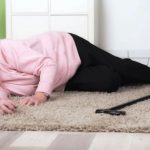 Falls are one of the biggest threats to the health of elderly people, with 85% of hospital admissions for senior citizens caused by falls. I’ve written a few times about various technological solutions to help prevent falls, whether it’s games, virtual reality or wearable devices. A recent study from the University of Alberta set out to explore how effective such solutions actually are.
Falls are one of the biggest threats to the health of elderly people, with 85% of hospital admissions for senior citizens caused by falls. I’ve written a few times about various technological solutions to help prevent falls, whether it’s games, virtual reality or wearable devices. A recent study from the University of Alberta set out to explore how effective such solutions actually are.
The paper suggests that the fall detection technologies currently on the market often flatter to deceive and need to be much more rigorously tested outside of the lab environment to learn how people use them in practice.
“It’s disturbing to think that these technologies aren’t properly tested for the real world, to be used by people who very much depend on them,” the authors say.
Testing in the field
The team reviewed 118 peer-reviewed studies published around the world in three languages. The studies all focused on the development and evaluation of fall detection devices. The analysis uncovered ten distinct types of monitoring technologies, including in-home sensors and wearable devices. Whilst the studies were interesting, the authors note that few of them analyzed whether the technology worked in a real-world setting, with the majority settling for experiments in a lab environment.
There was also precious little feedback from real users in the literature, with just three studies exploring issues such as user acceptance, with none examining user preferences.
“None of the studies addressed the fact that just because you have a piece of technology that works, doesn’t mean it works for the older adult,” the authors say.
For instance, one study showed that 80% of users were reluctant to activate their device after a fall, either because they struggled to do so, or because they didn’t want to disturb the caregiver who would receive the call.
“Not everyone who falls wants an immediate emergency dispatch. They might want to contact a neighbour instead or get up themselves. We need to have their input into what happens when they fall, and the technology doesn’t capture that,” the researchers say.
There also appeared to be a lack of attention given to the independence of the user, despite the majority of older people saying that independence was a key reason for them using such technology. What’s more, 90% of the studies failed to include any input from caregivers, whether professional or family.
The authors contend that a large number of devices are largely sitting unused because they fail to accurately address the needs of the consumer and their support network.
Costly solutions
Few of the studies examined the cost aspect of the technology, with 80% not addressing the question at all. Another 15% briefly touched on the issue without going any further than advocating that any technologies be low-priced.
That’s not to say things are all bad, merely that the research environment often restricts the ability of academia to work effectively with industry, and indeed with the public in their home environment where privacy and ethical considerations need to be taken into account.
It’s cooperation that does need to happen however, as the authors note that many products are the result of technological advances rather than medical knowledge. More work needs to be done therefore to ascertain their reliability and efficacy.